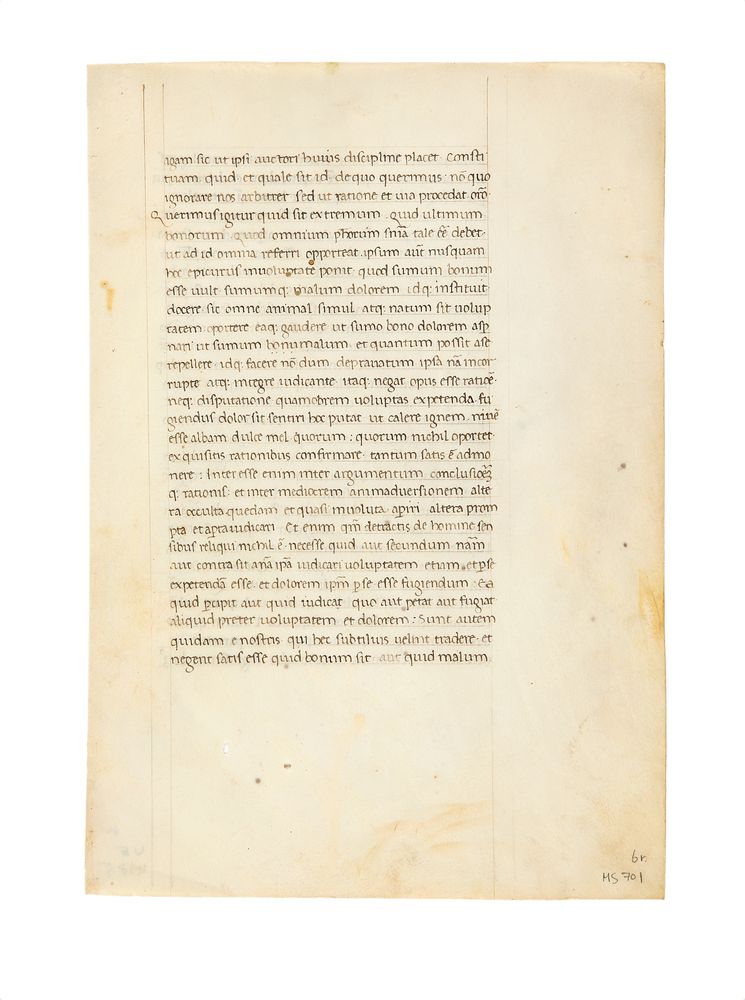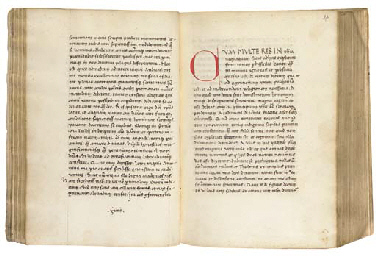CICERO, De finibus bonorum et malorum , in Latin, manuscript on vellum [Italy (Florence or the Veneto?), c.1460s/70s] A substantial fragment from a fine Italian Renaissance manuscript of a Classical author par excellence . 13 leaves, each c.250×175mm, with modern pencil foliation 6, 19, 61, 66, 68, 72–73, 75, 84, 91, 98, 101, and 103, a catchword on f.19v suggests that the parent volume was in gatherings of 10 leaves, ruled in plummet for 28 lines written below top line in a fine Humanistic bookhand, ruled space c.155×100mm (a few minor blemishes, but generally in very fine condition). Bound in grey buckram by Lisa Bøthun, Tønsberg, Norway, 2018. Provenance : (1) Owned c.1500 by Angelo Niccolini: inscribed ‘Angeli Nicholini Dec. Do. Laurentii et Amicorum’; in a ‘contemporary Venetian binding’ according to the 1900 Sotheby’s description; and with a stamp of the Niccolini Library, Florence (according to de Ricci; on this library, see D. Rhodes in Book Collector , 24 (1975), pp.125–9 (citing the present manuscript at p.125) and 603–06; reprinted in his Studies in Early European Printing and Book Collecting , 1983). (2) Payne & Foss, London: in their catalogue for February 1830, no 1111 (nos. 1109 and 1112 were also from the Niccolini Library); bought by: (3) Sir Thomas Phillipps (d.1872), his MS 4548; Phillipps sale at Sotheby’s, 17 May 1897, lot 198, bought by Edwards. (4) Sotheby’s, 25 July 1900, lot 1132, bought by Leighton for 5s. (5) Preston A. Perry: his sale in New York, 21 April 1908, lot 269, bought by: (6) Coella Lindsay Ricketts (d.1941), of Chicago (de Ricci, Census , I, p.651 no.220, with 111 leaves). (7) Otto Ege (d.1951) (see S. Gwara, Otto Ege ’ s Manuscripts , 2013, Handlist no 143): pencil inscriptions in the lower margin of some leaves; the present group were among the 19 leaves sold as part of the residue of his collection at Sotheby’s, 26 November 1985, lot 79 (‘dated by Otto Ege 1463’), bought by Maggs. (8) Schøyen Collection, MS 701. Texts : Marcus Tullius Cicero (106 - 43 B.C.) was without a doubt one of the most influential orators, politicians and philosophers of the Roman world. A prolific writer, De Finibus is his most extensive philosophical work, dealing with the philosophical views of Epicureanism, Stoicism, and the Platonism of Antiochus of Ascalon. The present leaves contain parts of De finibus Book I chapters 9–10, II 5–6, IV 2–3, 9–11, 12–13, 17–19 (2 leaves), 21–23, V 5–7, 14–15, 23–34, 26–28, 29–30. Script : This is a good example of the classic type of Humanistic bookhand, its debt to Carolingian minuscule clearly shown by the rounded letter-forms and the ample spacing of letters, words, and lines, and the use of very few abbreviations, to achieve a script of remarkable legibility. Otto Ege and Elizabeth his widow sometimes dated his manuscripts precisely if there was a colophon, but sometimes also invented precise dates, as in the present case: two are inscribed by her in pencil with the date ‘1456’ and another ‘1466’.
CICERO, De finibus bonorum et malorum , in Latin, manuscript on vellum [Italy (Florence or the Veneto?), c.1460s/70s] A substantial fragment from a fine Italian Renaissance manuscript of a Classical author par excellence . 13 leaves, each c.250×175mm, with modern pencil foliation 6, 19, 61, 66, 68, 72–73, 75, 84, 91, 98, 101, and 103, a catchword on f.19v suggests that the parent volume was in gatherings of 10 leaves, ruled in plummet for 28 lines written below top line in a fine Humanistic bookhand, ruled space c.155×100mm (a few minor blemishes, but generally in very fine condition). Bound in grey buckram by Lisa Bøthun, Tønsberg, Norway, 2018. Provenance : (1) Owned c.1500 by Angelo Niccolini: inscribed ‘Angeli Nicholini Dec. Do. Laurentii et Amicorum’; in a ‘contemporary Venetian binding’ according to the 1900 Sotheby’s description; and with a stamp of the Niccolini Library, Florence (according to de Ricci; on this library, see D. Rhodes in Book Collector , 24 (1975), pp.125–9 (citing the present manuscript at p.125) and 603–06; reprinted in his Studies in Early European Printing and Book Collecting , 1983). (2) Payne & Foss, London: in their catalogue for February 1830, no 1111 (nos. 1109 and 1112 were also from the Niccolini Library); bought by: (3) Sir Thomas Phillipps (d.1872), his MS 4548; Phillipps sale at Sotheby’s, 17 May 1897, lot 198, bought by Edwards. (4) Sotheby’s, 25 July 1900, lot 1132, bought by Leighton for 5s. (5) Preston A. Perry: his sale in New York, 21 April 1908, lot 269, bought by: (6) Coella Lindsay Ricketts (d.1941), of Chicago (de Ricci, Census , I, p.651 no.220, with 111 leaves). (7) Otto Ege (d.1951) (see S. Gwara, Otto Ege ’ s Manuscripts , 2013, Handlist no 143): pencil inscriptions in the lower margin of some leaves; the present group were among the 19 leaves sold as part of the residue of his collection at Sotheby’s, 26 November 1985, lot 79 (‘dated by Otto Ege 1463’), bought by Maggs. (8) Schøyen Collection, MS 701. Texts : Marcus Tullius Cicero (106 - 43 B.C.) was without a doubt one of the most influential orators, politicians and philosophers of the Roman world. A prolific writer, De Finibus is his most extensive philosophical work, dealing with the philosophical views of Epicureanism, Stoicism, and the Platonism of Antiochus of Ascalon. The present leaves contain parts of De finibus Book I chapters 9–10, II 5–6, IV 2–3, 9–11, 12–13, 17–19 (2 leaves), 21–23, V 5–7, 14–15, 23–34, 26–28, 29–30. Script : This is a good example of the classic type of Humanistic bookhand, its debt to Carolingian minuscule clearly shown by the rounded letter-forms and the ample spacing of letters, words, and lines, and the use of very few abbreviations, to achieve a script of remarkable legibility. Otto Ege and Elizabeth his widow sometimes dated his manuscripts precisely if there was a colophon, but sometimes also invented precise dates, as in the present case: two are inscribed by her in pencil with the date ‘1456’ and another ‘1466’.



.jpg)
.jpg)










Try LotSearch and its premium features for 7 days - without any costs!
Be notified automatically about new items in upcoming auctions.
Create an alert